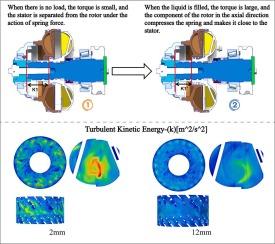Research on power loss’s principle and reduction optimization of auxiliary braking device—hydraulic retarder
IF 5.4
2区 工程技术
Q1 ENGINEERING, MULTIDISCIPLINARY
Engineering Science and Technology-An International Journal-Jestech
Pub Date : 2025-05-30
DOI:10.1016/j.jestch.2025.102092
引用次数: 0
Abstract
Hydraulic retarder is an auxiliary braking device for heavy commercial vehicles. Although there is no oil in the oil chamber when it is not working, the high-speed rotating rotor still drives and stirs the internal air. This will result in a certain amount of extra power loss. Aerodynamic power loss is related to cavity volume, residual oil and impeller’s structural parameters. The existing methods to suppress power loss need to improve the cavity’s internal structure or add auxiliary mechanisms, which are costly and difficult to implement, and it will affect the normal braking performance. In order to effectively suppress the power loss of hydraulic retarder, we propose a suppression method by applying large stiffness’ spring between stator and rotor, which can suppress the power loss by rapidly expanding the cavity volume. This method has the least modification and does not affect the normal braking performance of working chamber. The calculation model of flow channel has been established with different cavity volumes. The analysis method about three-dimensional flow field is used to research the internal physical field in working chamber’s gas phase at different rotating speeds. We have obtained the internal flow field characteristics, external loss torque and power characteristics of hydraulic retarder. The results based on the comparison of dynamic performance experimental equipment has shown that the spring with large stiffness can rapidly increase the cavity volume and effectively reduce the circular gas flow in working chamber. When the spring stiffness is large enough and the gap is 12 mm, the maximum power loss is 3.79 kW. The maximum loss power is reduced by 65 %. When it is compared with 7.12 kW at low stiffness. So that, the experiments show that the method by applying large stiffness spring in working chamber can significantly suppress power loss. This measure is applied to the structural design of hydraulic retarder, which can reduce the cost of design and manufacturing. Meanwhile, it improves the power utilization rate of vehicle, and does not affect the normal braking characteristics of hydraulic retarder.

辅助制动装置-液力缓速器功率损耗原理及减小优化研究
液力缓速器是重型商用车的辅助制动装置。虽然不工作时油腔内没有油,但高速旋转的转子仍带动并搅拌内部空气。这将导致一定数量的额外功率损失。气动功率损失与空腔体积、残余油和叶轮结构参数有关。现有的抑制功率损耗的方法需要改进空腔内部结构或增加辅助机构,这些方法成本高、实施难度大,而且会影响正常的制动性能。为了有效抑制液力缓速器的功率损失,提出了在定子和转子之间施加大刚度弹簧的抑制方法,通过快速扩大腔体体积来抑制功率损失。该方法修改最少,不影响工作腔的正常制动性能。建立了不同空腔体积下的流道计算模型。采用三维流场分析方法,对不同转速下工作腔气相内部物理场进行了研究。得到了液力缓速器的内部流场特性、外部损失转矩和功率特性。通过与实验设备的动态性能对比,结果表明,大刚度弹簧可以快速增加腔体体积,有效降低工作室内的循环气体流量。当弹簧刚度足够大,间隙为12mm时,最大功率损失为3.79 kW。最大损耗功率降低65%。当与7.12 kW低刚度时进行比较。因此,实验表明,在工作室内施加大刚度弹簧的方法可以显著抑制功率损失。将此方法应用到液力缓速器的结构设计中,可以降低设计和制造成本。同时提高了车辆的动力利用率,且不影响液力缓速器的正常制动特性。
本文章由计算机程序翻译,如有差异,请以英文原文为准。
求助全文
约1分钟内获得全文
求助全文
来源期刊

Engineering Science and Technology-An International Journal-Jestech
Materials Science-Electronic, Optical and Magnetic Materials
CiteScore
11.20
自引率
3.50%
发文量
153
审稿时长
22 days
期刊介绍:
Engineering Science and Technology, an International Journal (JESTECH) (formerly Technology), a peer-reviewed quarterly engineering journal, publishes both theoretical and experimental high quality papers of permanent interest, not previously published in journals, in the field of engineering and applied science which aims to promote the theory and practice of technology and engineering. In addition to peer-reviewed original research papers, the Editorial Board welcomes original research reports, state-of-the-art reviews and communications in the broadly defined field of engineering science and technology.
The scope of JESTECH includes a wide spectrum of subjects including:
-Electrical/Electronics and Computer Engineering (Biomedical Engineering and Instrumentation; Coding, Cryptography, and Information Protection; Communications, Networks, Mobile Computing and Distributed Systems; Compilers and Operating Systems; Computer Architecture, Parallel Processing, and Dependability; Computer Vision and Robotics; Control Theory; Electromagnetic Waves, Microwave Techniques and Antennas; Embedded Systems; Integrated Circuits, VLSI Design, Testing, and CAD; Microelectromechanical Systems; Microelectronics, and Electronic Devices and Circuits; Power, Energy and Energy Conversion Systems; Signal, Image, and Speech Processing)
-Mechanical and Civil Engineering (Automotive Technologies; Biomechanics; Construction Materials; Design and Manufacturing; Dynamics and Control; Energy Generation, Utilization, Conversion, and Storage; Fluid Mechanics and Hydraulics; Heat and Mass Transfer; Micro-Nano Sciences; Renewable and Sustainable Energy Technologies; Robotics and Mechatronics; Solid Mechanics and Structure; Thermal Sciences)
-Metallurgical and Materials Engineering (Advanced Materials Science; Biomaterials; Ceramic and Inorgnanic Materials; Electronic-Magnetic Materials; Energy and Environment; Materials Characterizastion; Metallurgy; Polymers and Nanocomposites)
 求助内容:
求助内容: 应助结果提醒方式:
应助结果提醒方式:


